Analysis of the Diversity Policy of Starbucks
VerifiedAdded on 2023/01/06
|12
|3059
|24
AI Summary
This analysis explores the diversity policy of Starbucks, including its corporate culture, organizational structure, managerial flaws, and local store culture. Recommendations are provided for internal growth opportunities and the creation of retail employee networks.
Contribute Materials
Your contribution can guide someone’s learning journey. Share your
documents today.
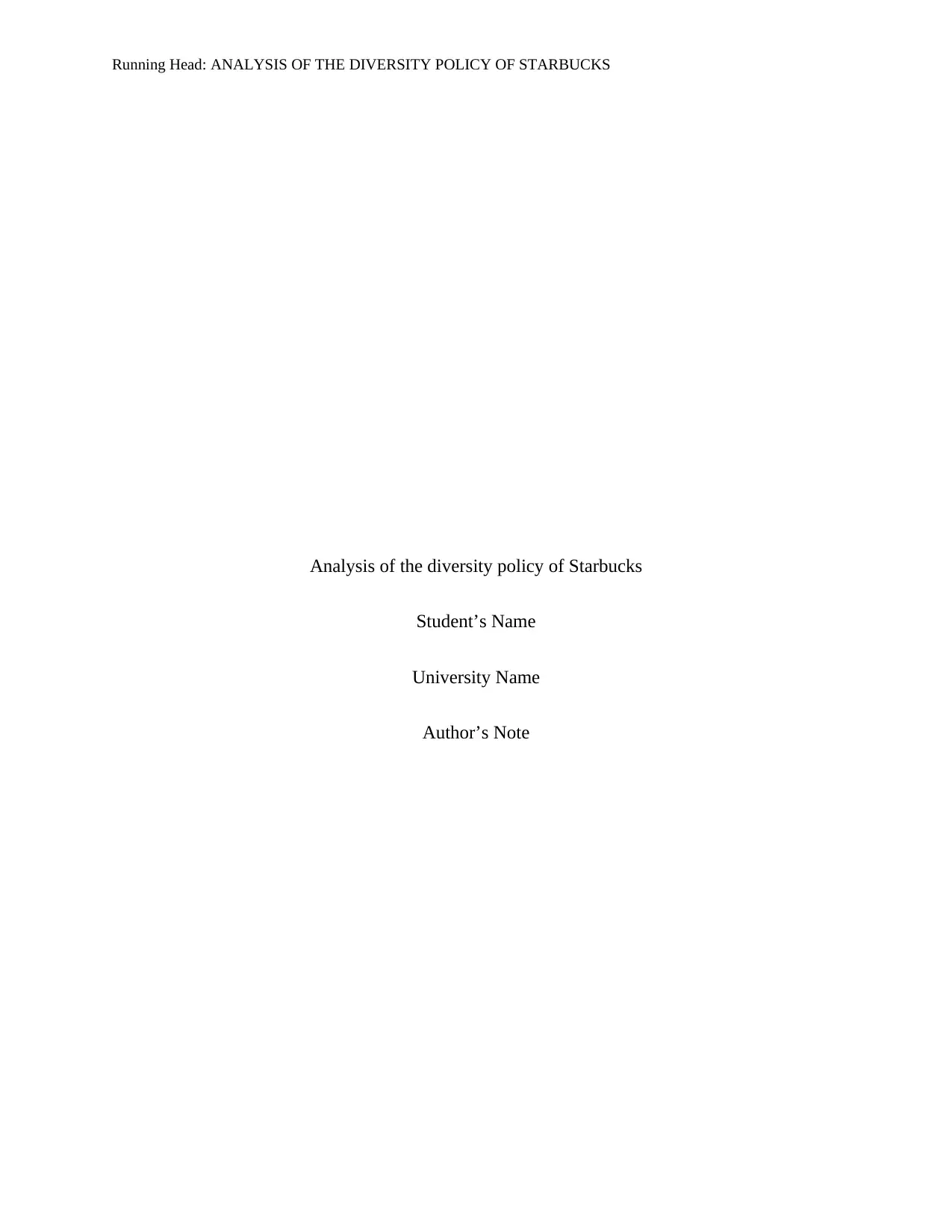
Running Head: ANALYSIS OF THE DIVERSITY POLICY OF STARBUCKS
Analysis of the diversity policy of Starbucks
Student’s Name
University Name
Author’s Note
Analysis of the diversity policy of Starbucks
Student’s Name
University Name
Author’s Note
Secure Best Marks with AI Grader
Need help grading? Try our AI Grader for instant feedback on your assignments.
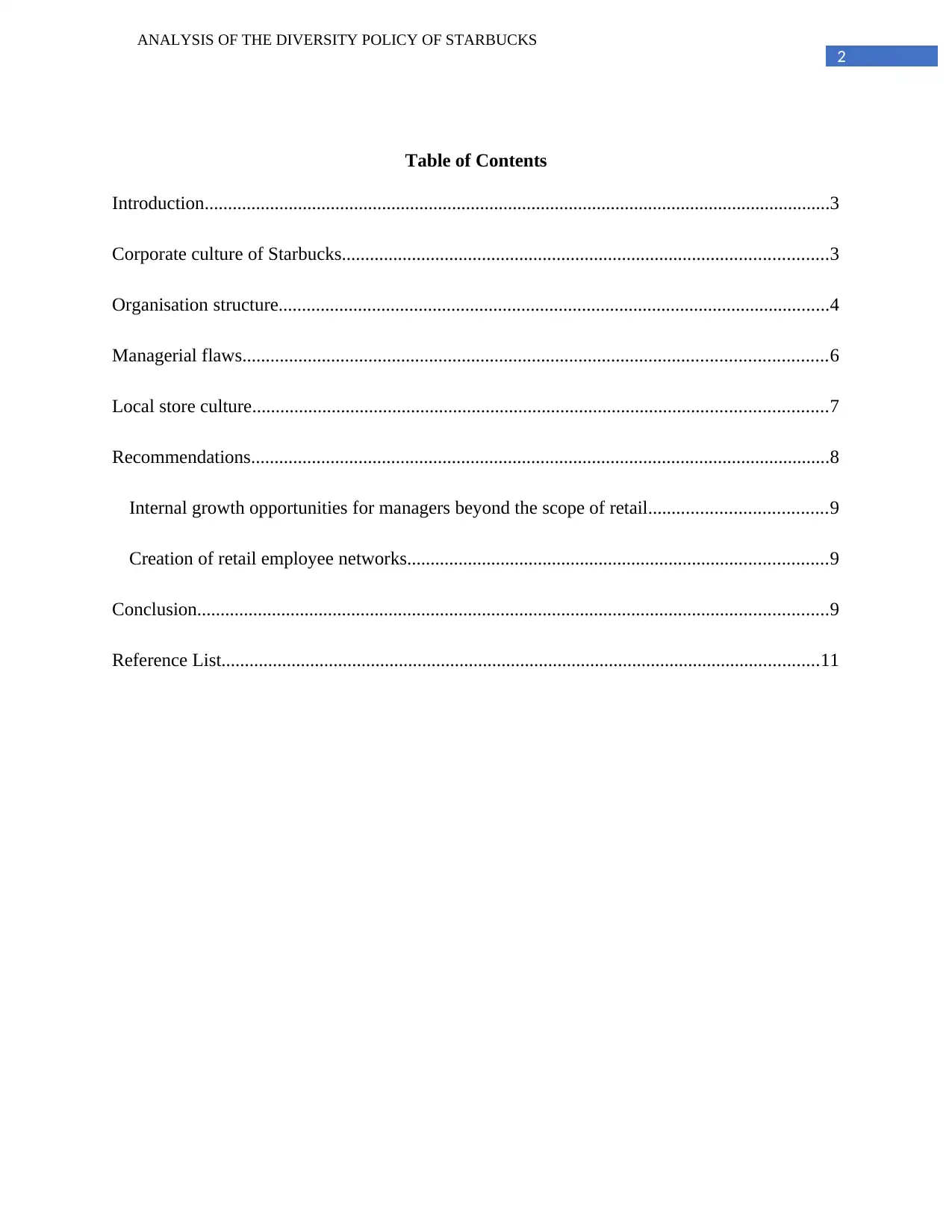
2
ANALYSIS OF THE DIVERSITY POLICY OF STARBUCKS
Table of Contents
Introduction......................................................................................................................................3
Corporate culture of Starbucks........................................................................................................3
Organisation structure......................................................................................................................4
Managerial flaws.............................................................................................................................6
Local store culture...........................................................................................................................7
Recommendations............................................................................................................................8
Internal growth opportunities for managers beyond the scope of retail......................................9
Creation of retail employee networks..........................................................................................9
Conclusion.......................................................................................................................................9
Reference List................................................................................................................................11
ANALYSIS OF THE DIVERSITY POLICY OF STARBUCKS
Table of Contents
Introduction......................................................................................................................................3
Corporate culture of Starbucks........................................................................................................3
Organisation structure......................................................................................................................4
Managerial flaws.............................................................................................................................6
Local store culture...........................................................................................................................7
Recommendations............................................................................................................................8
Internal growth opportunities for managers beyond the scope of retail......................................9
Creation of retail employee networks..........................................................................................9
Conclusion.......................................................................................................................................9
Reference List................................................................................................................................11
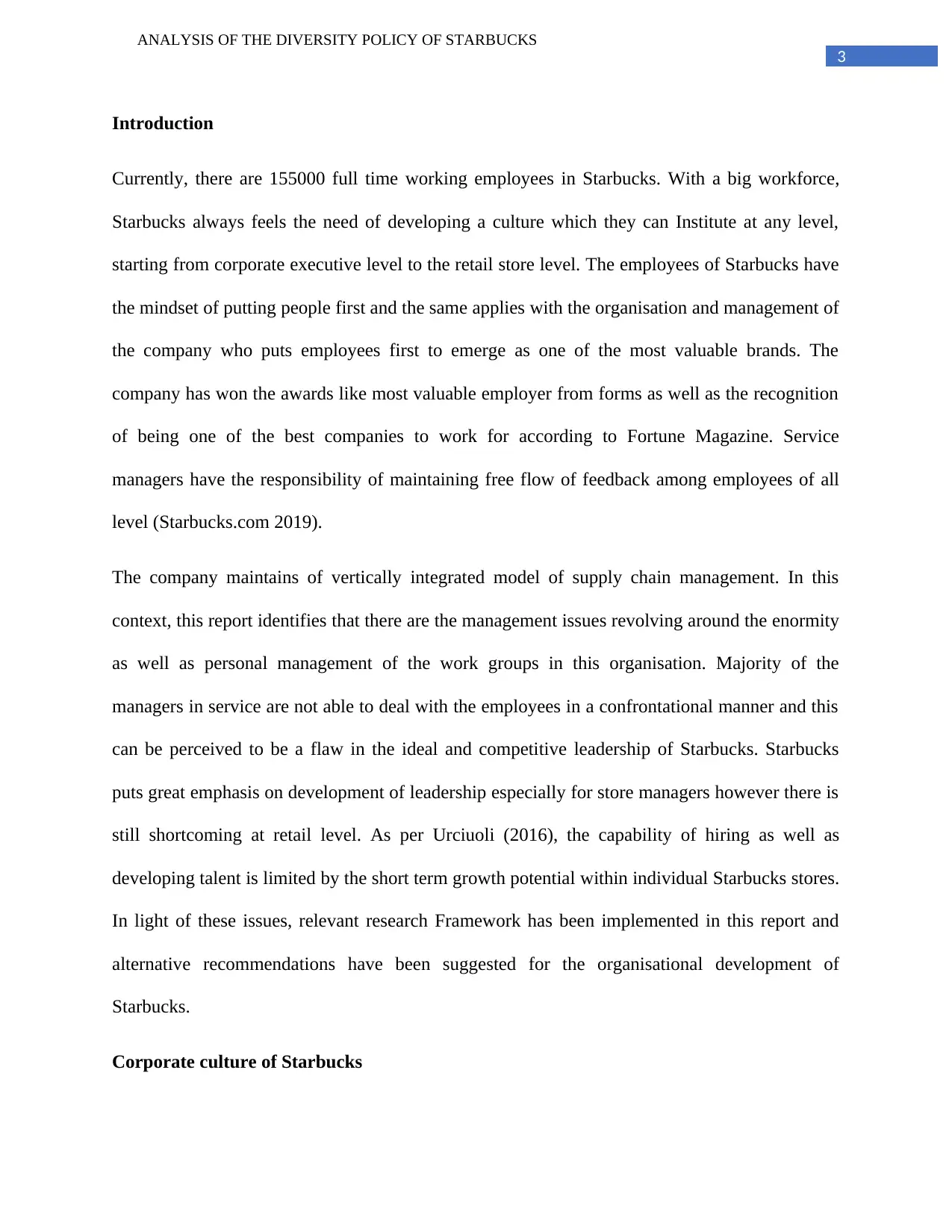
3
ANALYSIS OF THE DIVERSITY POLICY OF STARBUCKS
Introduction
Currently, there are 155000 full time working employees in Starbucks. With a big workforce,
Starbucks always feels the need of developing a culture which they can Institute at any level,
starting from corporate executive level to the retail store level. The employees of Starbucks have
the mindset of putting people first and the same applies with the organisation and management of
the company who puts employees first to emerge as one of the most valuable brands. The
company has won the awards like most valuable employer from forms as well as the recognition
of being one of the best companies to work for according to Fortune Magazine. Service
managers have the responsibility of maintaining free flow of feedback among employees of all
level (Starbucks.com 2019).
The company maintains of vertically integrated model of supply chain management. In this
context, this report identifies that there are the management issues revolving around the enormity
as well as personal management of the work groups in this organisation. Majority of the
managers in service are not able to deal with the employees in a confrontational manner and this
can be perceived to be a flaw in the ideal and competitive leadership of Starbucks. Starbucks
puts great emphasis on development of leadership especially for store managers however there is
still shortcoming at retail level. As per Urciuoli (2016), the capability of hiring as well as
developing talent is limited by the short term growth potential within individual Starbucks stores.
In light of these issues, relevant research Framework has been implemented in this report and
alternative recommendations have been suggested for the organisational development of
Starbucks.
Corporate culture of Starbucks
ANALYSIS OF THE DIVERSITY POLICY OF STARBUCKS
Introduction
Currently, there are 155000 full time working employees in Starbucks. With a big workforce,
Starbucks always feels the need of developing a culture which they can Institute at any level,
starting from corporate executive level to the retail store level. The employees of Starbucks have
the mindset of putting people first and the same applies with the organisation and management of
the company who puts employees first to emerge as one of the most valuable brands. The
company has won the awards like most valuable employer from forms as well as the recognition
of being one of the best companies to work for according to Fortune Magazine. Service
managers have the responsibility of maintaining free flow of feedback among employees of all
level (Starbucks.com 2019).
The company maintains of vertically integrated model of supply chain management. In this
context, this report identifies that there are the management issues revolving around the enormity
as well as personal management of the work groups in this organisation. Majority of the
managers in service are not able to deal with the employees in a confrontational manner and this
can be perceived to be a flaw in the ideal and competitive leadership of Starbucks. Starbucks
puts great emphasis on development of leadership especially for store managers however there is
still shortcoming at retail level. As per Urciuoli (2016), the capability of hiring as well as
developing talent is limited by the short term growth potential within individual Starbucks stores.
In light of these issues, relevant research Framework has been implemented in this report and
alternative recommendations have been suggested for the organisational development of
Starbucks.
Corporate culture of Starbucks
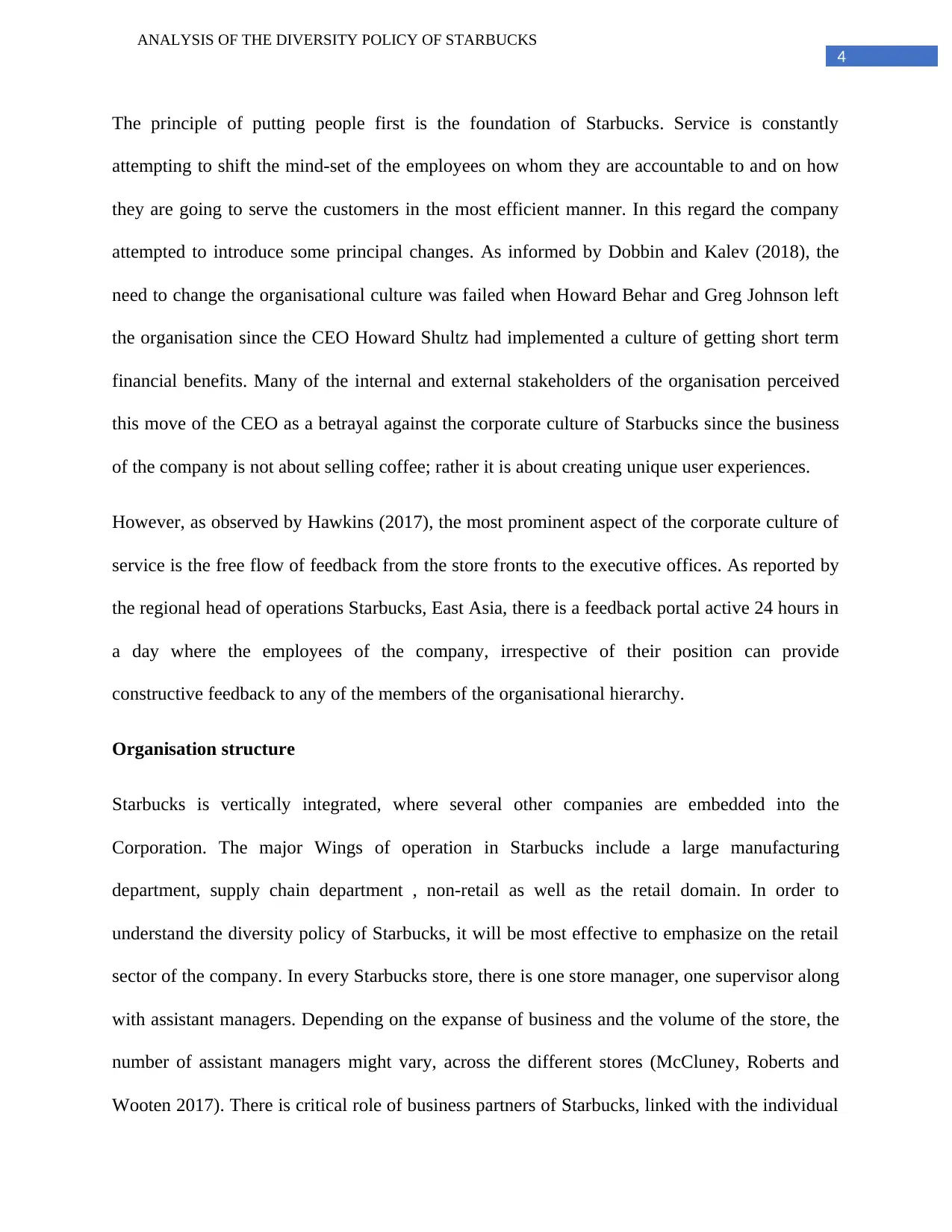
4
ANALYSIS OF THE DIVERSITY POLICY OF STARBUCKS
The principle of putting people first is the foundation of Starbucks. Service is constantly
attempting to shift the mind-set of the employees on whom they are accountable to and on how
they are going to serve the customers in the most efficient manner. In this regard the company
attempted to introduce some principal changes. As informed by Dobbin and Kalev (2018), the
need to change the organisational culture was failed when Howard Behar and Greg Johnson left
the organisation since the CEO Howard Shultz had implemented a culture of getting short term
financial benefits. Many of the internal and external stakeholders of the organisation perceived
this move of the CEO as a betrayal against the corporate culture of Starbucks since the business
of the company is not about selling coffee; rather it is about creating unique user experiences.
However, as observed by Hawkins (2017), the most prominent aspect of the corporate culture of
service is the free flow of feedback from the store fronts to the executive offices. As reported by
the regional head of operations Starbucks, East Asia, there is a feedback portal active 24 hours in
a day where the employees of the company, irrespective of their position can provide
constructive feedback to any of the members of the organisational hierarchy.
Organisation structure
Starbucks is vertically integrated, where several other companies are embedded into the
Corporation. The major Wings of operation in Starbucks include a large manufacturing
department, supply chain department , non-retail as well as the retail domain. In order to
understand the diversity policy of Starbucks, it will be most effective to emphasize on the retail
sector of the company. In every Starbucks store, there is one store manager, one supervisor along
with assistant managers. Depending on the expanse of business and the volume of the store, the
number of assistant managers might vary, across the different stores (McCluney, Roberts and
Wooten 2017). There is critical role of business partners of Starbucks, linked with the individual
ANALYSIS OF THE DIVERSITY POLICY OF STARBUCKS
The principle of putting people first is the foundation of Starbucks. Service is constantly
attempting to shift the mind-set of the employees on whom they are accountable to and on how
they are going to serve the customers in the most efficient manner. In this regard the company
attempted to introduce some principal changes. As informed by Dobbin and Kalev (2018), the
need to change the organisational culture was failed when Howard Behar and Greg Johnson left
the organisation since the CEO Howard Shultz had implemented a culture of getting short term
financial benefits. Many of the internal and external stakeholders of the organisation perceived
this move of the CEO as a betrayal against the corporate culture of Starbucks since the business
of the company is not about selling coffee; rather it is about creating unique user experiences.
However, as observed by Hawkins (2017), the most prominent aspect of the corporate culture of
service is the free flow of feedback from the store fronts to the executive offices. As reported by
the regional head of operations Starbucks, East Asia, there is a feedback portal active 24 hours in
a day where the employees of the company, irrespective of their position can provide
constructive feedback to any of the members of the organisational hierarchy.
Organisation structure
Starbucks is vertically integrated, where several other companies are embedded into the
Corporation. The major Wings of operation in Starbucks include a large manufacturing
department, supply chain department , non-retail as well as the retail domain. In order to
understand the diversity policy of Starbucks, it will be most effective to emphasize on the retail
sector of the company. In every Starbucks store, there is one store manager, one supervisor along
with assistant managers. Depending on the expanse of business and the volume of the store, the
number of assistant managers might vary, across the different stores (McCluney, Roberts and
Wooten 2017). There is critical role of business partners of Starbucks, linked with the individual
Secure Best Marks with AI Grader
Need help grading? Try our AI Grader for instant feedback on your assignments.
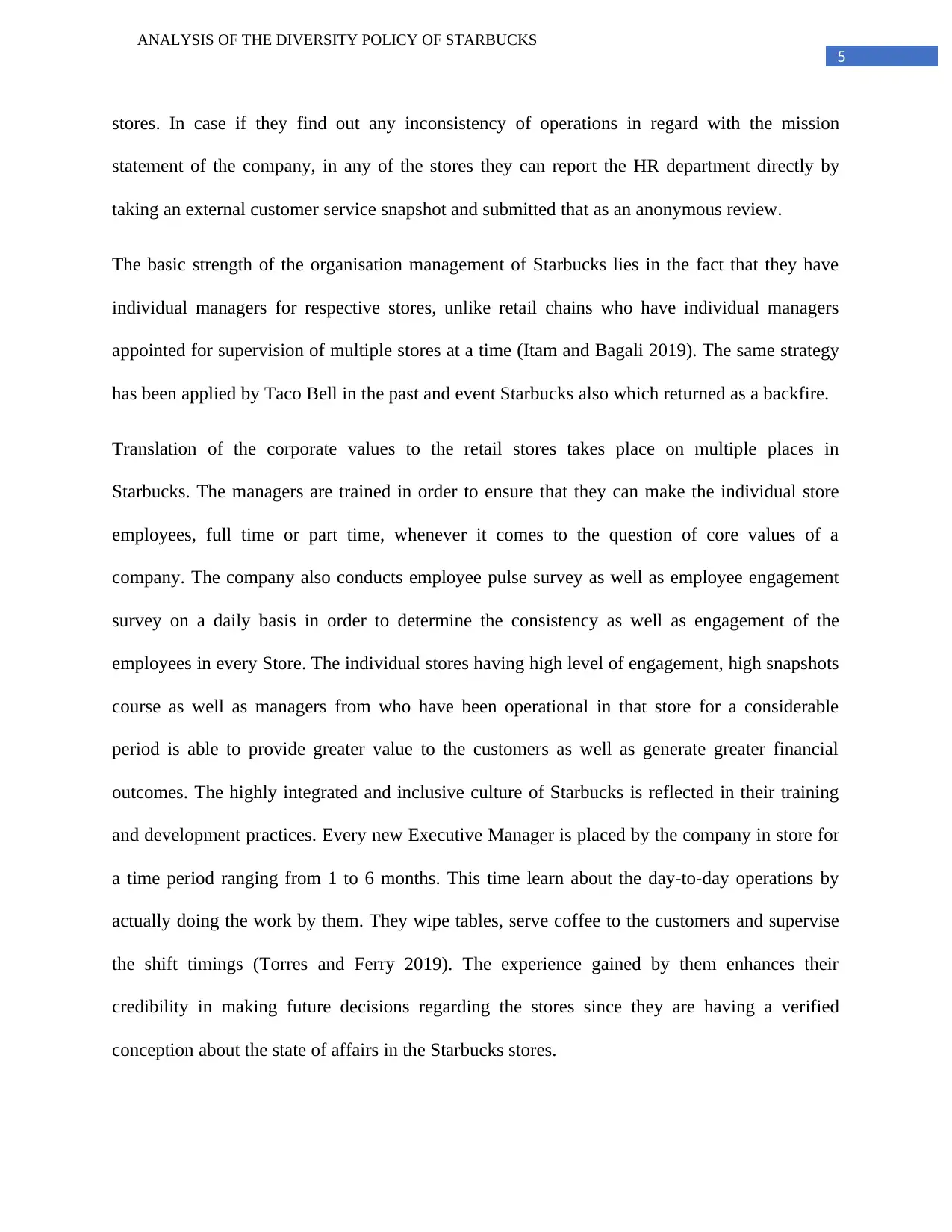
5
ANALYSIS OF THE DIVERSITY POLICY OF STARBUCKS
stores. In case if they find out any inconsistency of operations in regard with the mission
statement of the company, in any of the stores they can report the HR department directly by
taking an external customer service snapshot and submitted that as an anonymous review.
The basic strength of the organisation management of Starbucks lies in the fact that they have
individual managers for respective stores, unlike retail chains who have individual managers
appointed for supervision of multiple stores at a time (Itam and Bagali 2019). The same strategy
has been applied by Taco Bell in the past and event Starbucks also which returned as a backfire.
Translation of the corporate values to the retail stores takes place on multiple places in
Starbucks. The managers are trained in order to ensure that they can make the individual store
employees, full time or part time, whenever it comes to the question of core values of a
company. The company also conducts employee pulse survey as well as employee engagement
survey on a daily basis in order to determine the consistency as well as engagement of the
employees in every Store. The individual stores having high level of engagement, high snapshots
course as well as managers from who have been operational in that store for a considerable
period is able to provide greater value to the customers as well as generate greater financial
outcomes. The highly integrated and inclusive culture of Starbucks is reflected in their training
and development practices. Every new Executive Manager is placed by the company in store for
a time period ranging from 1 to 6 months. This time learn about the day-to-day operations by
actually doing the work by them. They wipe tables, serve coffee to the customers and supervise
the shift timings (Torres and Ferry 2019). The experience gained by them enhances their
credibility in making future decisions regarding the stores since they are having a verified
conception about the state of affairs in the Starbucks stores.
ANALYSIS OF THE DIVERSITY POLICY OF STARBUCKS
stores. In case if they find out any inconsistency of operations in regard with the mission
statement of the company, in any of the stores they can report the HR department directly by
taking an external customer service snapshot and submitted that as an anonymous review.
The basic strength of the organisation management of Starbucks lies in the fact that they have
individual managers for respective stores, unlike retail chains who have individual managers
appointed for supervision of multiple stores at a time (Itam and Bagali 2019). The same strategy
has been applied by Taco Bell in the past and event Starbucks also which returned as a backfire.
Translation of the corporate values to the retail stores takes place on multiple places in
Starbucks. The managers are trained in order to ensure that they can make the individual store
employees, full time or part time, whenever it comes to the question of core values of a
company. The company also conducts employee pulse survey as well as employee engagement
survey on a daily basis in order to determine the consistency as well as engagement of the
employees in every Store. The individual stores having high level of engagement, high snapshots
course as well as managers from who have been operational in that store for a considerable
period is able to provide greater value to the customers as well as generate greater financial
outcomes. The highly integrated and inclusive culture of Starbucks is reflected in their training
and development practices. Every new Executive Manager is placed by the company in store for
a time period ranging from 1 to 6 months. This time learn about the day-to-day operations by
actually doing the work by them. They wipe tables, serve coffee to the customers and supervise
the shift timings (Torres and Ferry 2019). The experience gained by them enhances their
credibility in making future decisions regarding the stores since they are having a verified
conception about the state of affairs in the Starbucks stores.
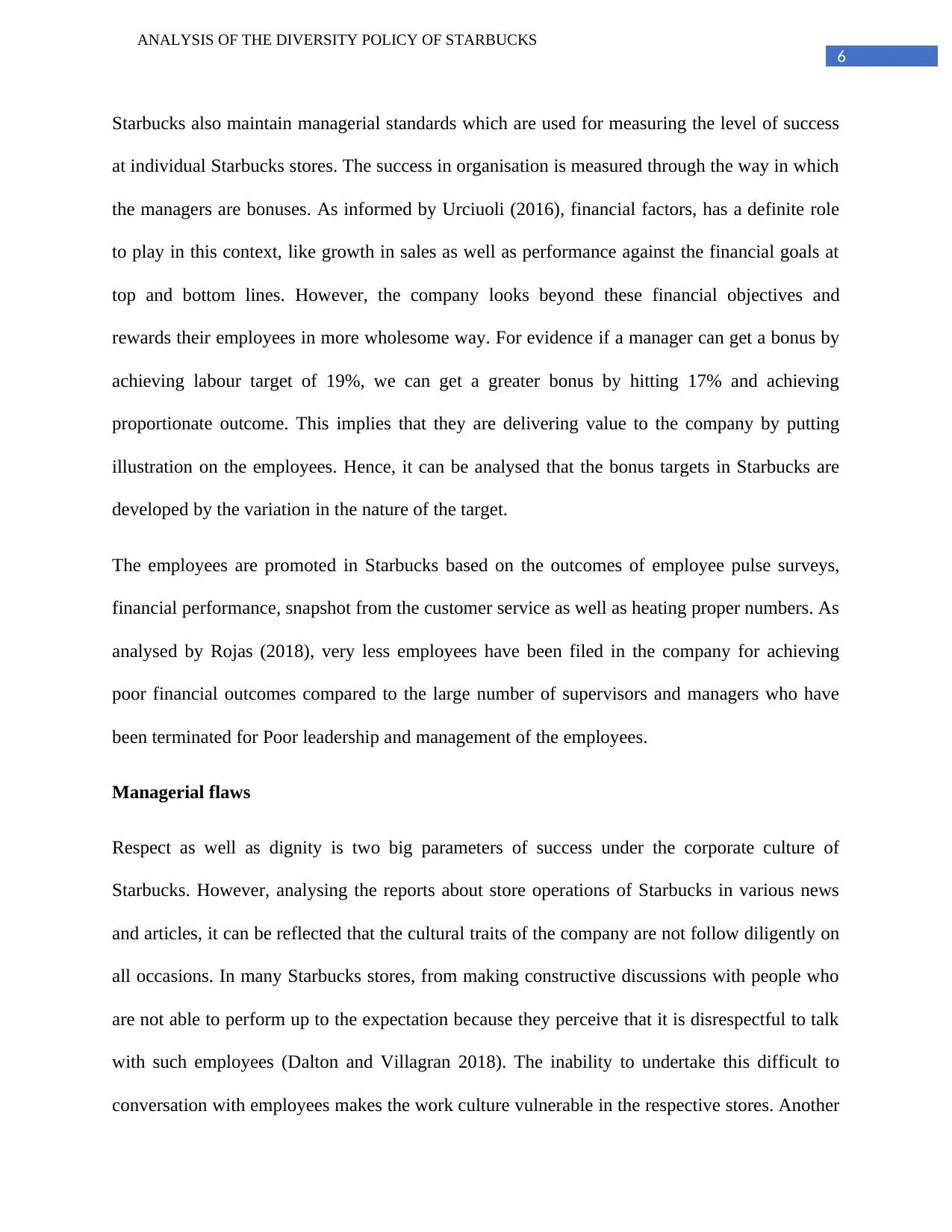
6
ANALYSIS OF THE DIVERSITY POLICY OF STARBUCKS
Starbucks also maintain managerial standards which are used for measuring the level of success
at individual Starbucks stores. The success in organisation is measured through the way in which
the managers are bonuses. As informed by Urciuoli (2016), financial factors, has a definite role
to play in this context, like growth in sales as well as performance against the financial goals at
top and bottom lines. However, the company looks beyond these financial objectives and
rewards their employees in more wholesome way. For evidence if a manager can get a bonus by
achieving labour target of 19%, we can get a greater bonus by hitting 17% and achieving
proportionate outcome. This implies that they are delivering value to the company by putting
illustration on the employees. Hence, it can be analysed that the bonus targets in Starbucks are
developed by the variation in the nature of the target.
The employees are promoted in Starbucks based on the outcomes of employee pulse surveys,
financial performance, snapshot from the customer service as well as heating proper numbers. As
analysed by Rojas (2018), very less employees have been filed in the company for achieving
poor financial outcomes compared to the large number of supervisors and managers who have
been terminated for Poor leadership and management of the employees.
Managerial flaws
Respect as well as dignity is two big parameters of success under the corporate culture of
Starbucks. However, analysing the reports about store operations of Starbucks in various news
and articles, it can be reflected that the cultural traits of the company are not follow diligently on
all occasions. In many Starbucks stores, from making constructive discussions with people who
are not able to perform up to the expectation because they perceive that it is disrespectful to talk
with such employees (Dalton and Villagran 2018). The inability to undertake this difficult to
conversation with employees makes the work culture vulnerable in the respective stores. Another
ANALYSIS OF THE DIVERSITY POLICY OF STARBUCKS
Starbucks also maintain managerial standards which are used for measuring the level of success
at individual Starbucks stores. The success in organisation is measured through the way in which
the managers are bonuses. As informed by Urciuoli (2016), financial factors, has a definite role
to play in this context, like growth in sales as well as performance against the financial goals at
top and bottom lines. However, the company looks beyond these financial objectives and
rewards their employees in more wholesome way. For evidence if a manager can get a bonus by
achieving labour target of 19%, we can get a greater bonus by hitting 17% and achieving
proportionate outcome. This implies that they are delivering value to the company by putting
illustration on the employees. Hence, it can be analysed that the bonus targets in Starbucks are
developed by the variation in the nature of the target.
The employees are promoted in Starbucks based on the outcomes of employee pulse surveys,
financial performance, snapshot from the customer service as well as heating proper numbers. As
analysed by Rojas (2018), very less employees have been filed in the company for achieving
poor financial outcomes compared to the large number of supervisors and managers who have
been terminated for Poor leadership and management of the employees.
Managerial flaws
Respect as well as dignity is two big parameters of success under the corporate culture of
Starbucks. However, analysing the reports about store operations of Starbucks in various news
and articles, it can be reflected that the cultural traits of the company are not follow diligently on
all occasions. In many Starbucks stores, from making constructive discussions with people who
are not able to perform up to the expectation because they perceive that it is disrespectful to talk
with such employees (Dalton and Villagran 2018). The inability to undertake this difficult to
conversation with employees makes the work culture vulnerable in the respective stores. Another
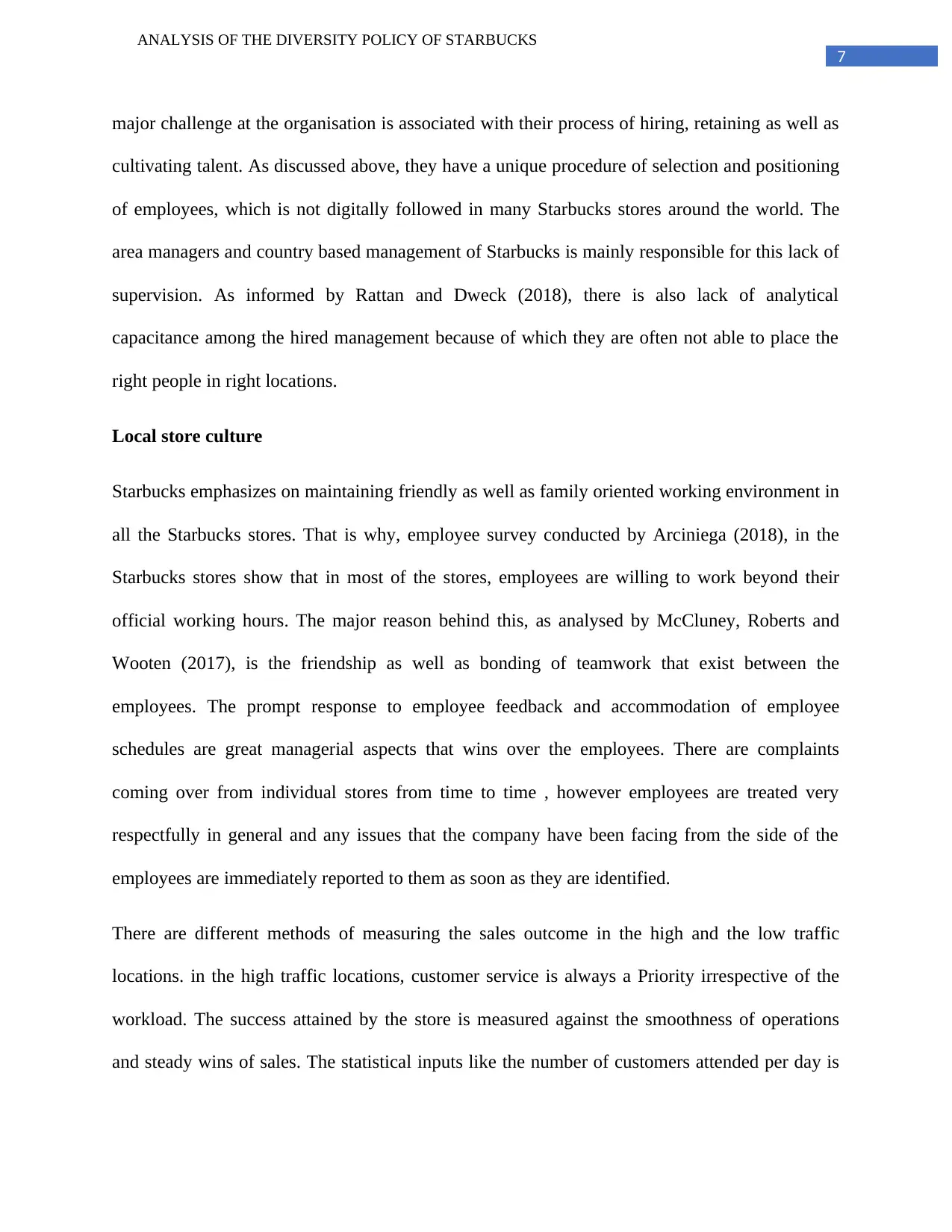
7
ANALYSIS OF THE DIVERSITY POLICY OF STARBUCKS
major challenge at the organisation is associated with their process of hiring, retaining as well as
cultivating talent. As discussed above, they have a unique procedure of selection and positioning
of employees, which is not digitally followed in many Starbucks stores around the world. The
area managers and country based management of Starbucks is mainly responsible for this lack of
supervision. As informed by Rattan and Dweck (2018), there is also lack of analytical
capacitance among the hired management because of which they are often not able to place the
right people in right locations.
Local store culture
Starbucks emphasizes on maintaining friendly as well as family oriented working environment in
all the Starbucks stores. That is why, employee survey conducted by Arciniega (2018), in the
Starbucks stores show that in most of the stores, employees are willing to work beyond their
official working hours. The major reason behind this, as analysed by McCluney, Roberts and
Wooten (2017), is the friendship as well as bonding of teamwork that exist between the
employees. The prompt response to employee feedback and accommodation of employee
schedules are great managerial aspects that wins over the employees. There are complaints
coming over from individual stores from time to time , however employees are treated very
respectfully in general and any issues that the company have been facing from the side of the
employees are immediately reported to them as soon as they are identified.
There are different methods of measuring the sales outcome in the high and the low traffic
locations. in the high traffic locations, customer service is always a Priority irrespective of the
workload. The success attained by the store is measured against the smoothness of operations
and steady wins of sales. The statistical inputs like the number of customers attended per day is
ANALYSIS OF THE DIVERSITY POLICY OF STARBUCKS
major challenge at the organisation is associated with their process of hiring, retaining as well as
cultivating talent. As discussed above, they have a unique procedure of selection and positioning
of employees, which is not digitally followed in many Starbucks stores around the world. The
area managers and country based management of Starbucks is mainly responsible for this lack of
supervision. As informed by Rattan and Dweck (2018), there is also lack of analytical
capacitance among the hired management because of which they are often not able to place the
right people in right locations.
Local store culture
Starbucks emphasizes on maintaining friendly as well as family oriented working environment in
all the Starbucks stores. That is why, employee survey conducted by Arciniega (2018), in the
Starbucks stores show that in most of the stores, employees are willing to work beyond their
official working hours. The major reason behind this, as analysed by McCluney, Roberts and
Wooten (2017), is the friendship as well as bonding of teamwork that exist between the
employees. The prompt response to employee feedback and accommodation of employee
schedules are great managerial aspects that wins over the employees. There are complaints
coming over from individual stores from time to time , however employees are treated very
respectfully in general and any issues that the company have been facing from the side of the
employees are immediately reported to them as soon as they are identified.
There are different methods of measuring the sales outcome in the high and the low traffic
locations. in the high traffic locations, customer service is always a Priority irrespective of the
workload. The success attained by the store is measured against the smoothness of operations
and steady wins of sales. The statistical inputs like the number of customers attended per day is
Paraphrase This Document
Need a fresh take? Get an instant paraphrase of this document with our AI Paraphraser
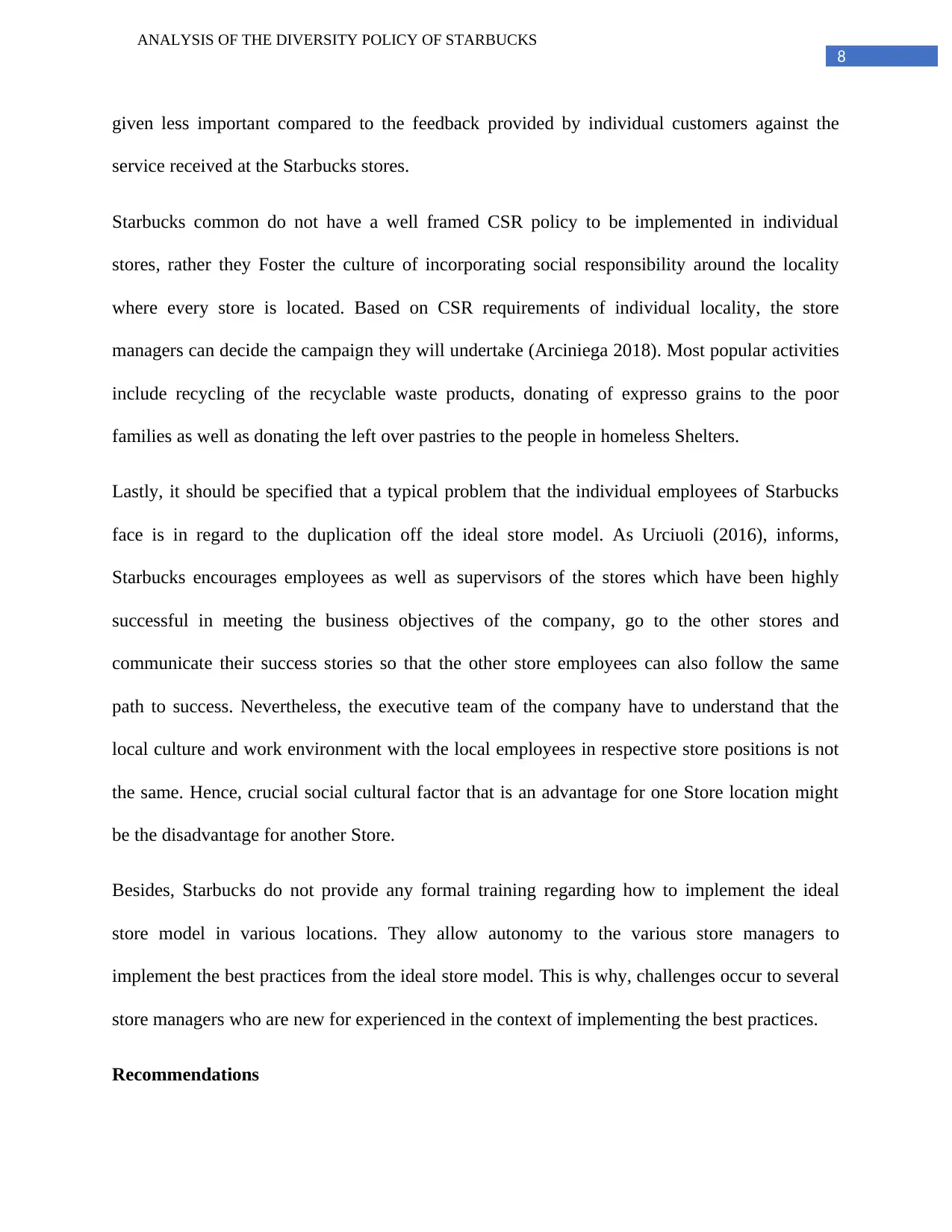
8
ANALYSIS OF THE DIVERSITY POLICY OF STARBUCKS
given less important compared to the feedback provided by individual customers against the
service received at the Starbucks stores.
Starbucks common do not have a well framed CSR policy to be implemented in individual
stores, rather they Foster the culture of incorporating social responsibility around the locality
where every store is located. Based on CSR requirements of individual locality, the store
managers can decide the campaign they will undertake (Arciniega 2018). Most popular activities
include recycling of the recyclable waste products, donating of expresso grains to the poor
families as well as donating the left over pastries to the people in homeless Shelters.
Lastly, it should be specified that a typical problem that the individual employees of Starbucks
face is in regard to the duplication off the ideal store model. As Urciuoli (2016), informs,
Starbucks encourages employees as well as supervisors of the stores which have been highly
successful in meeting the business objectives of the company, go to the other stores and
communicate their success stories so that the other store employees can also follow the same
path to success. Nevertheless, the executive team of the company have to understand that the
local culture and work environment with the local employees in respective store positions is not
the same. Hence, crucial social cultural factor that is an advantage for one Store location might
be the disadvantage for another Store.
Besides, Starbucks do not provide any formal training regarding how to implement the ideal
store model in various locations. They allow autonomy to the various store managers to
implement the best practices from the ideal store model. This is why, challenges occur to several
store managers who are new for experienced in the context of implementing the best practices.
Recommendations
ANALYSIS OF THE DIVERSITY POLICY OF STARBUCKS
given less important compared to the feedback provided by individual customers against the
service received at the Starbucks stores.
Starbucks common do not have a well framed CSR policy to be implemented in individual
stores, rather they Foster the culture of incorporating social responsibility around the locality
where every store is located. Based on CSR requirements of individual locality, the store
managers can decide the campaign they will undertake (Arciniega 2018). Most popular activities
include recycling of the recyclable waste products, donating of expresso grains to the poor
families as well as donating the left over pastries to the people in homeless Shelters.
Lastly, it should be specified that a typical problem that the individual employees of Starbucks
face is in regard to the duplication off the ideal store model. As Urciuoli (2016), informs,
Starbucks encourages employees as well as supervisors of the stores which have been highly
successful in meeting the business objectives of the company, go to the other stores and
communicate their success stories so that the other store employees can also follow the same
path to success. Nevertheless, the executive team of the company have to understand that the
local culture and work environment with the local employees in respective store positions is not
the same. Hence, crucial social cultural factor that is an advantage for one Store location might
be the disadvantage for another Store.
Besides, Starbucks do not provide any formal training regarding how to implement the ideal
store model in various locations. They allow autonomy to the various store managers to
implement the best practices from the ideal store model. This is why, challenges occur to several
store managers who are new for experienced in the context of implementing the best practices.
Recommendations
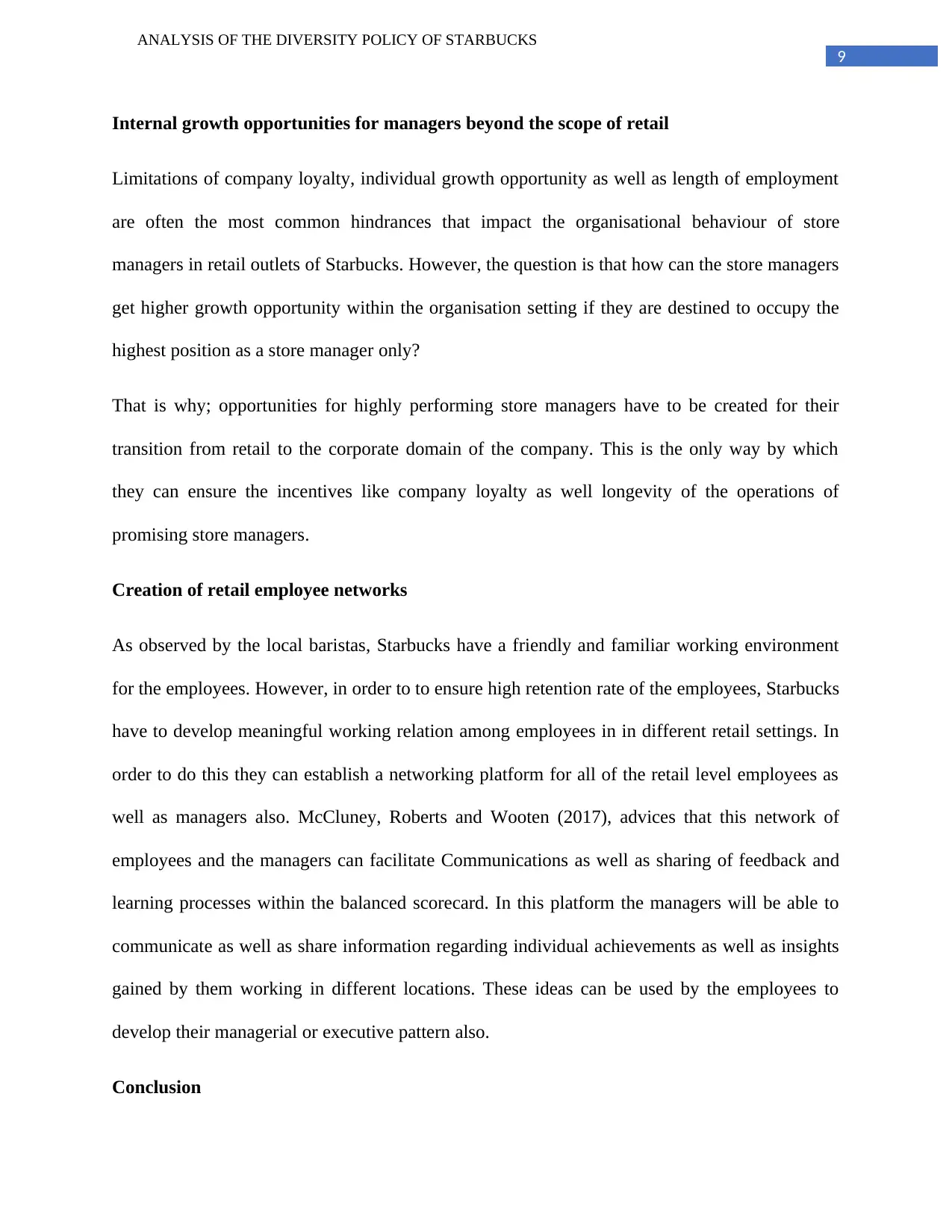
9
ANALYSIS OF THE DIVERSITY POLICY OF STARBUCKS
Internal growth opportunities for managers beyond the scope of retail
Limitations of company loyalty, individual growth opportunity as well as length of employment
are often the most common hindrances that impact the organisational behaviour of store
managers in retail outlets of Starbucks. However, the question is that how can the store managers
get higher growth opportunity within the organisation setting if they are destined to occupy the
highest position as a store manager only?
That is why; opportunities for highly performing store managers have to be created for their
transition from retail to the corporate domain of the company. This is the only way by which
they can ensure the incentives like company loyalty as well longevity of the operations of
promising store managers.
Creation of retail employee networks
As observed by the local baristas, Starbucks have a friendly and familiar working environment
for the employees. However, in order to to ensure high retention rate of the employees, Starbucks
have to develop meaningful working relation among employees in in different retail settings. In
order to do this they can establish a networking platform for all of the retail level employees as
well as managers also. McCluney, Roberts and Wooten (2017), advices that this network of
employees and the managers can facilitate Communications as well as sharing of feedback and
learning processes within the balanced scorecard. In this platform the managers will be able to
communicate as well as share information regarding individual achievements as well as insights
gained by them working in different locations. These ideas can be used by the employees to
develop their managerial or executive pattern also.
Conclusion
ANALYSIS OF THE DIVERSITY POLICY OF STARBUCKS
Internal growth opportunities for managers beyond the scope of retail
Limitations of company loyalty, individual growth opportunity as well as length of employment
are often the most common hindrances that impact the organisational behaviour of store
managers in retail outlets of Starbucks. However, the question is that how can the store managers
get higher growth opportunity within the organisation setting if they are destined to occupy the
highest position as a store manager only?
That is why; opportunities for highly performing store managers have to be created for their
transition from retail to the corporate domain of the company. This is the only way by which
they can ensure the incentives like company loyalty as well longevity of the operations of
promising store managers.
Creation of retail employee networks
As observed by the local baristas, Starbucks have a friendly and familiar working environment
for the employees. However, in order to to ensure high retention rate of the employees, Starbucks
have to develop meaningful working relation among employees in in different retail settings. In
order to do this they can establish a networking platform for all of the retail level employees as
well as managers also. McCluney, Roberts and Wooten (2017), advices that this network of
employees and the managers can facilitate Communications as well as sharing of feedback and
learning processes within the balanced scorecard. In this platform the managers will be able to
communicate as well as share information regarding individual achievements as well as insights
gained by them working in different locations. These ideas can be used by the employees to
develop their managerial or executive pattern also.
Conclusion
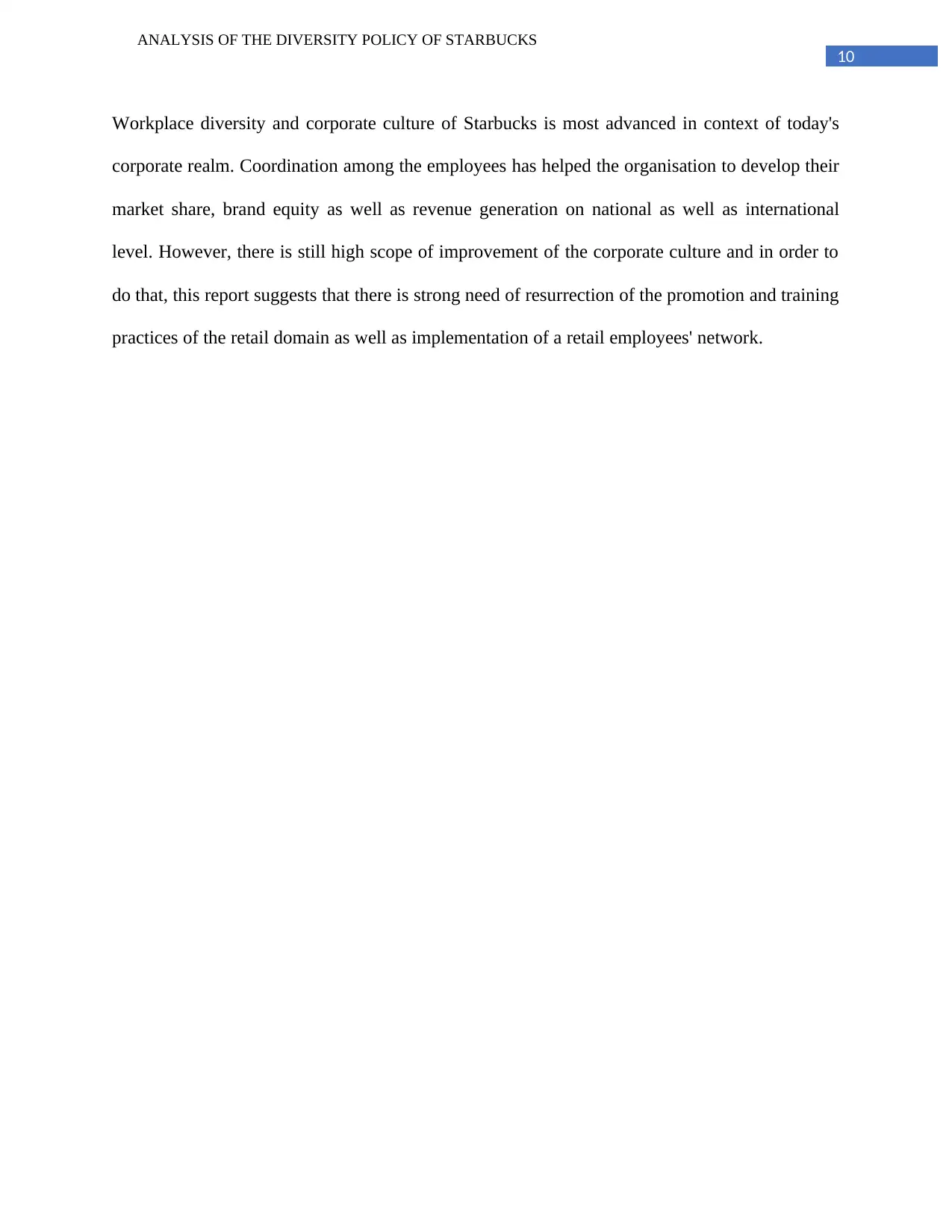
10
ANALYSIS OF THE DIVERSITY POLICY OF STARBUCKS
Workplace diversity and corporate culture of Starbucks is most advanced in context of today's
corporate realm. Coordination among the employees has helped the organisation to develop their
market share, brand equity as well as revenue generation on national as well as international
level. However, there is still high scope of improvement of the corporate culture and in order to
do that, this report suggests that there is strong need of resurrection of the promotion and training
practices of the retail domain as well as implementation of a retail employees' network.
ANALYSIS OF THE DIVERSITY POLICY OF STARBUCKS
Workplace diversity and corporate culture of Starbucks is most advanced in context of today's
corporate realm. Coordination among the employees has helped the organisation to develop their
market share, brand equity as well as revenue generation on national as well as international
level. However, there is still high scope of improvement of the corporate culture and in order to
do that, this report suggests that there is strong need of resurrection of the promotion and training
practices of the retail domain as well as implementation of a retail employees' network.
Secure Best Marks with AI Grader
Need help grading? Try our AI Grader for instant feedback on your assignments.
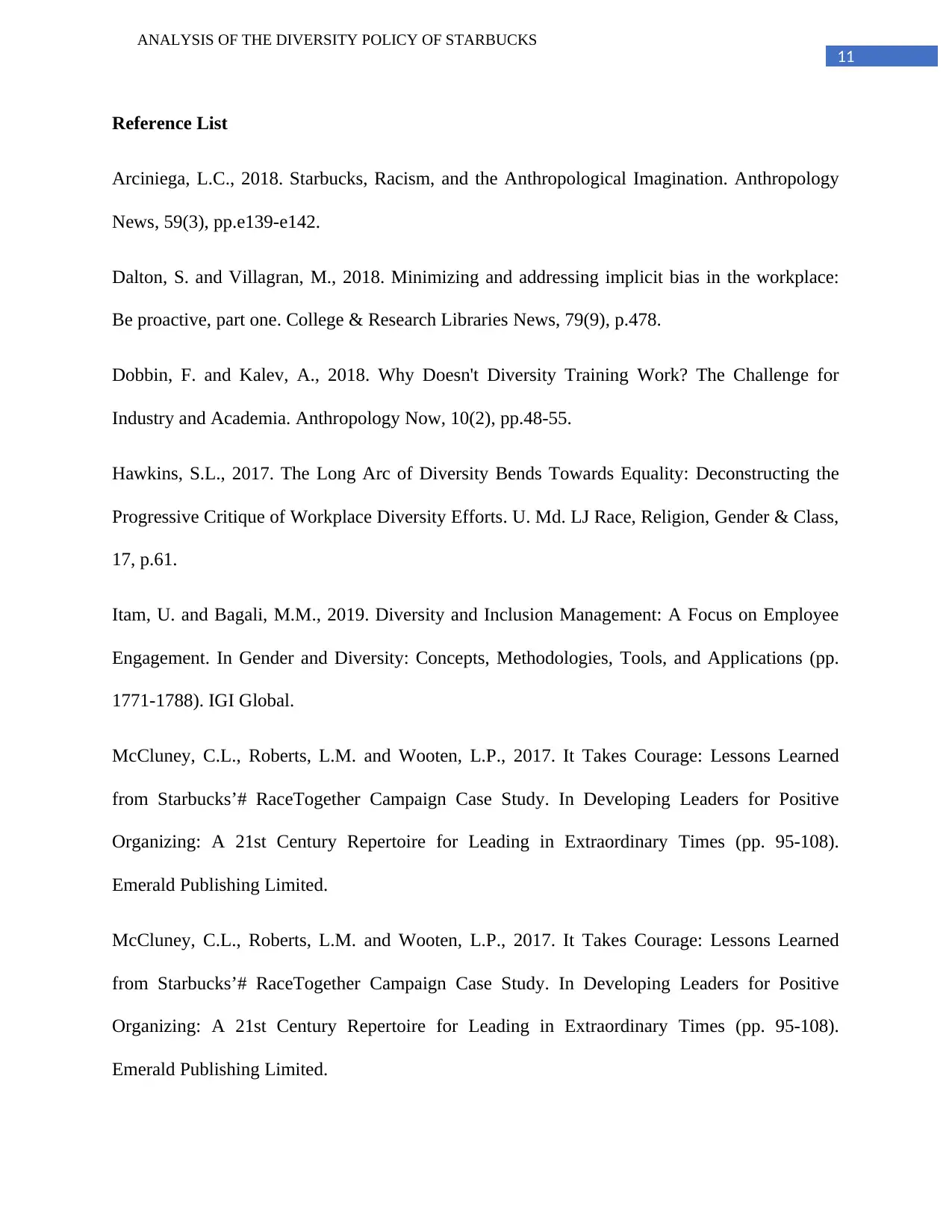
11
ANALYSIS OF THE DIVERSITY POLICY OF STARBUCKS
Reference List
Arciniega, L.C., 2018. Starbucks, Racism, and the Anthropological Imagination. Anthropology
News, 59(3), pp.e139-e142.
Dalton, S. and Villagran, M., 2018. Minimizing and addressing implicit bias in the workplace:
Be proactive, part one. College & Research Libraries News, 79(9), p.478.
Dobbin, F. and Kalev, A., 2018. Why Doesn't Diversity Training Work? The Challenge for
Industry and Academia. Anthropology Now, 10(2), pp.48-55.
Hawkins, S.L., 2017. The Long Arc of Diversity Bends Towards Equality: Deconstructing the
Progressive Critique of Workplace Diversity Efforts. U. Md. LJ Race, Religion, Gender & Class,
17, p.61.
Itam, U. and Bagali, M.M., 2019. Diversity and Inclusion Management: A Focus on Employee
Engagement. In Gender and Diversity: Concepts, Methodologies, Tools, and Applications (pp.
1771-1788). IGI Global.
McCluney, C.L., Roberts, L.M. and Wooten, L.P., 2017. It Takes Courage: Lessons Learned
from Starbucks’# RaceTogether Campaign Case Study. In Developing Leaders for Positive
Organizing: A 21st Century Repertoire for Leading in Extraordinary Times (pp. 95-108).
Emerald Publishing Limited.
McCluney, C.L., Roberts, L.M. and Wooten, L.P., 2017. It Takes Courage: Lessons Learned
from Starbucks’# RaceTogether Campaign Case Study. In Developing Leaders for Positive
Organizing: A 21st Century Repertoire for Leading in Extraordinary Times (pp. 95-108).
Emerald Publishing Limited.
ANALYSIS OF THE DIVERSITY POLICY OF STARBUCKS
Reference List
Arciniega, L.C., 2018. Starbucks, Racism, and the Anthropological Imagination. Anthropology
News, 59(3), pp.e139-e142.
Dalton, S. and Villagran, M., 2018. Minimizing and addressing implicit bias in the workplace:
Be proactive, part one. College & Research Libraries News, 79(9), p.478.
Dobbin, F. and Kalev, A., 2018. Why Doesn't Diversity Training Work? The Challenge for
Industry and Academia. Anthropology Now, 10(2), pp.48-55.
Hawkins, S.L., 2017. The Long Arc of Diversity Bends Towards Equality: Deconstructing the
Progressive Critique of Workplace Diversity Efforts. U. Md. LJ Race, Religion, Gender & Class,
17, p.61.
Itam, U. and Bagali, M.M., 2019. Diversity and Inclusion Management: A Focus on Employee
Engagement. In Gender and Diversity: Concepts, Methodologies, Tools, and Applications (pp.
1771-1788). IGI Global.
McCluney, C.L., Roberts, L.M. and Wooten, L.P., 2017. It Takes Courage: Lessons Learned
from Starbucks’# RaceTogether Campaign Case Study. In Developing Leaders for Positive
Organizing: A 21st Century Repertoire for Leading in Extraordinary Times (pp. 95-108).
Emerald Publishing Limited.
McCluney, C.L., Roberts, L.M. and Wooten, L.P., 2017. It Takes Courage: Lessons Learned
from Starbucks’# RaceTogether Campaign Case Study. In Developing Leaders for Positive
Organizing: A 21st Century Repertoire for Leading in Extraordinary Times (pp. 95-108).
Emerald Publishing Limited.
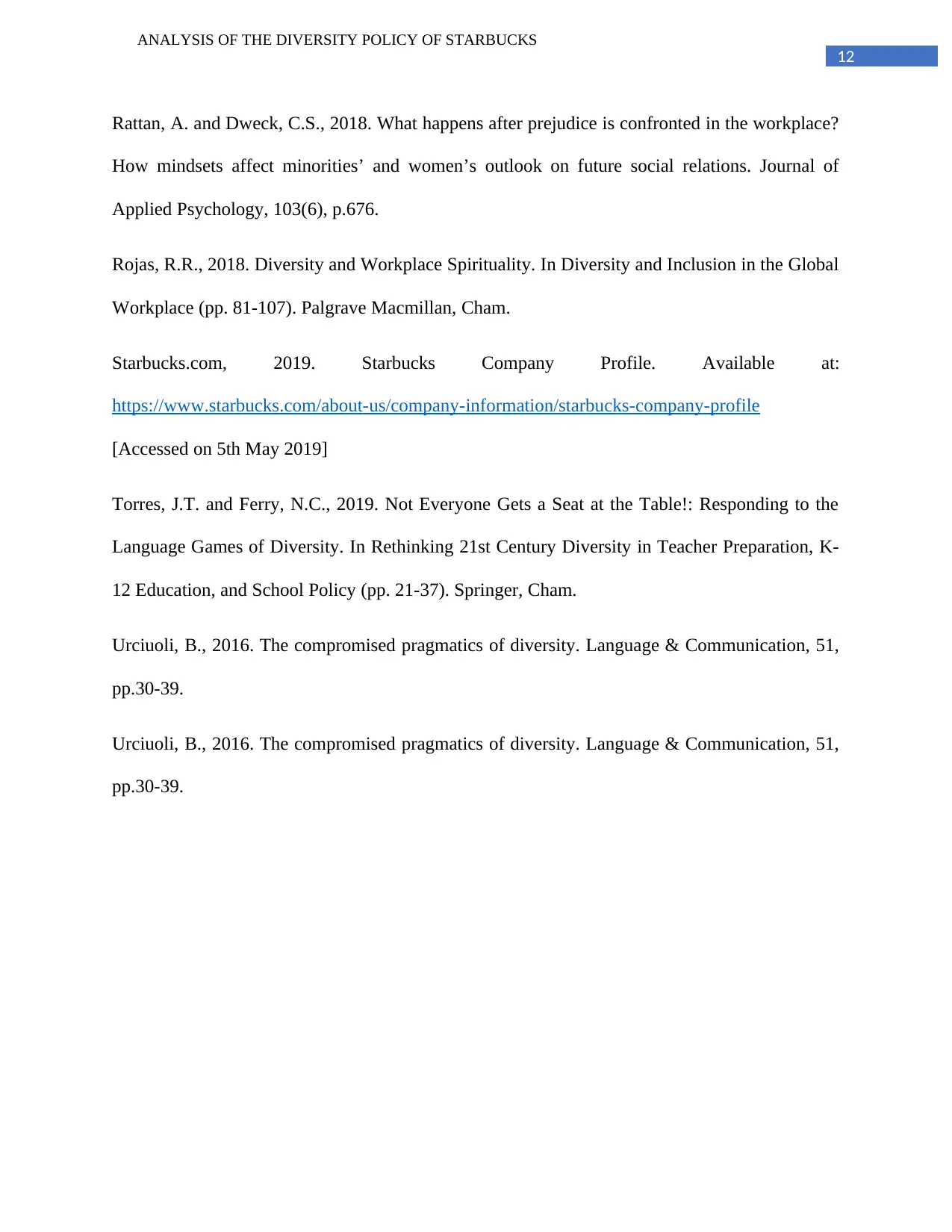
12
ANALYSIS OF THE DIVERSITY POLICY OF STARBUCKS
Rattan, A. and Dweck, C.S., 2018. What happens after prejudice is confronted in the workplace?
How mindsets affect minorities’ and women’s outlook on future social relations. Journal of
Applied Psychology, 103(6), p.676.
Rojas, R.R., 2018. Diversity and Workplace Spirituality. In Diversity and Inclusion in the Global
Workplace (pp. 81-107). Palgrave Macmillan, Cham.
Starbucks.com, 2019. Starbucks Company Profile. Available at:
https://www.starbucks.com/about-us/company-information/starbucks-company-profile
[Accessed on 5th May 2019]
Torres, J.T. and Ferry, N.C., 2019. Not Everyone Gets a Seat at the Table!: Responding to the
Language Games of Diversity. In Rethinking 21st Century Diversity in Teacher Preparation, K-
12 Education, and School Policy (pp. 21-37). Springer, Cham.
Urciuoli, B., 2016. The compromised pragmatics of diversity. Language & Communication, 51,
pp.30-39.
Urciuoli, B., 2016. The compromised pragmatics of diversity. Language & Communication, 51,
pp.30-39.
ANALYSIS OF THE DIVERSITY POLICY OF STARBUCKS
Rattan, A. and Dweck, C.S., 2018. What happens after prejudice is confronted in the workplace?
How mindsets affect minorities’ and women’s outlook on future social relations. Journal of
Applied Psychology, 103(6), p.676.
Rojas, R.R., 2018. Diversity and Workplace Spirituality. In Diversity and Inclusion in the Global
Workplace (pp. 81-107). Palgrave Macmillan, Cham.
Starbucks.com, 2019. Starbucks Company Profile. Available at:
https://www.starbucks.com/about-us/company-information/starbucks-company-profile
[Accessed on 5th May 2019]
Torres, J.T. and Ferry, N.C., 2019. Not Everyone Gets a Seat at the Table!: Responding to the
Language Games of Diversity. In Rethinking 21st Century Diversity in Teacher Preparation, K-
12 Education, and School Policy (pp. 21-37). Springer, Cham.
Urciuoli, B., 2016. The compromised pragmatics of diversity. Language & Communication, 51,
pp.30-39.
Urciuoli, B., 2016. The compromised pragmatics of diversity. Language & Communication, 51,
pp.30-39.
1 out of 12
![[object Object]](/_next/static/media/star-bottom.7253800d.svg)





